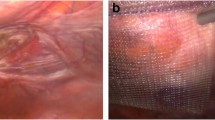Abstract
Purpose
To determine the incidence of enterocutaneous fistulas (ECFs) developed after elective incisional hernia (IH) repair using intraperitoneal uncoated polypropylene (PPE) mesh.
Methods
This is a retrospective descriptive study of a prospective cohort of patients undergoing elective IH repair using intraperitoneal uncoated PPE mesh at the Department of General Surgery of a high complexity University Hospital.
Results
Between January 1992 and December 2013, 695 IH repairs were performed using intraperitoneal uncoated PPE mesh. The omentum was placed between the mesh and bowel in 507 patients (73 %). In 188 patients (27 %) it was not possible to place the omentum between the mesh and bowel; therefore, in 69 patients (9.92 %) the PPE mesh was placed over the bowel, whereas in 119 patients (17.12 %) a Vicryl® mesh was placed between the bowel and PPE mesh. Six hundred and seventy-eight (97.5 %) IH repairs were open whereas 17 (2.5 %) were laparoscopic. Postoperative complications consisted of seroma (5.9 %), hematoma (4.3 %), wound infection (4.8 %), and mesh infection (4.0 %). Recurrence of IH occurred in 52 patients (7.4 %) after a mean follow-up of 59 months. Four (0.5 %) patients required additional surgery due to intestinal occlusion. Neither acute nor chronic ECFs were encountered during follow-up in 695 patients.
Conclusion
Based on these results, the placement of intraperitoneal uncoated PPE mesh for elective IH repair might be a safe procedure that is not associated with ECF formation.



Similar content being viewed by others
References
Kingsnorth A, LeBlanc K (2003) Hernias: inguinal and incisional. Lancet 362:1561–1571
Vrijland WW, Jeekel J, Steyerberg EW, den Hoed PT, Bonjer HJ (2000) Intraperitoneal polypropylene mesh repair of incisional hernia is not associated with enterocutaneous fistula. Br J Surg 87:348–352
Bernard C, Polliand C, Mutelica L, Champault G (2007) Repair of giant incisional abdominal wall hernias using open intraperitoneal mesh. Hernia 11:315–320
Coda A, Lamberti R, Martorana S (2012) Classification of prosthetics used in hernia repair based on weight and biomaterial. Hernia 16:9–20
Klinge U, Conze J, Krones CJ, Schumpelick V (2005) Incisional hernia: open techniques. World J Surg 29:1066–1072
Santora TA, Roslyn JJ (1993) Incisional hernia. Surg Clin N Am 73(3):557–570
Hamy A, Pessaux P, Mucci-Hennekinne S et al (2003) Surgical treatment of large incisional hernias by an intraperitoneal Dacron mesh and an aponeurotic graft. J Am Coll Surg 196:531–534
Franklin ME, Dorman JP, Glass JL, Balli JE, González JJ (1998) Laparoscopic ventral and incisional hernia repair. Surg Laparosc Endosc 8:294–299
Fry DE et al (2001) Infected abdominal wall prosthesis. In: Bendavid R (ed) Abdominal wall hernias: principles and management. (part XVII). Springer, New York, pp 707–713
Rudmik LR, Schieman C, Dixon E, Debru E (2006) Laparoscopic incisional hernia repair: a review of the literature. Hernia 10:110–119
Usher FC, Ochsner J, Tuttle LLJ (1958) Use of Marlex mesh in the repair of incisional hernias. Am Surg 24:969–974
Usher FC (1979) New technique for repairing incisional hernias with marlex mesh. Am J Surg 138:740–741
Kaufman Z, Engelberg M (1981) Fecal fistula: a late complication of Marlex mesh repair. Dis Colon Rectum 24:543–544
Muysoms FE, Miserez M, Berrevoet F et al (2009) Classification of primary and incisional abdominal wall hernias. Hernia 13:407–414
Centers for Disease Control and Prevention National and State Healthcare-Associated Procedure-associated Module SSI, published January 2016. Available at http://www.cdc.gov/nhsn/PDFs/pscManual/9pscSSIcurrent.pdf
Leber GE, Garb JL, Alexander AI, Reed WP (1998) Long-term complications associated with prosthetic repair of incisional hernias. Arch Surg 133:378–382
Chew DKW, Choi LH, Roger AM (2000) Enterocutaneous fistula 14 years after prosthetic mesh repair of a ventral incisional hernia: a life-long risk? Surgery 127:352–353
Ott V, Groebli Y, Schneider R (2005) Late intestinal fistula formation after incisional hernia using intraperitoneal mesh. Hernia 9:103–104
Burger JWA, Luijendijk RW, Hop WCJ et al (2004) Long-term follow-up of a randomized controlled trial of suture versus mesh repair of incisional hernia. Ann Surg 240:578–585
McLanahan D, King LT, Weems C, Novotney M, Gibson K (1997) Retrorectus prosthetic mesh repair of midline abdominal hernia. Am J Surg 173:445–449
Adloff M, Arnaud JP (1987) Surgical management of large incisional hernias by an intraperitoneal mersilene mesh and an aponeurotic graft. Surg Gynecol Obst 165:204–206
Arnaud JP, Cervi C, Tuech JJ, Cattan F (1997) Surgical treatment of post-operative incisional hernias by intra-peritoneal insertion of a Dacron mesh. A report on 220 cases. Hernia 1:97–99
Crovella F, Bartone G, Fei L (2008) Incisional hernia. Springer, Milan
Larson GM, Harrower HW (1978) Plastic mesh repair of incisional hernias. Am J Surg 135:559–563
DeGuzman LJ, Nyhus LM, Yared G, Schlesinger PK (1995) Colocutaneous fistula formation following polypropylene mesh placement for repair of a ventral hernia: diagnosis by colonoscopy. Endoscopy 27:459–461
Wantz GE et al (1999) Incisional hernias symposium. Incisional hernia: the problem and the cure. J Am Coll Surg 188:429–447
Afifi RY (2005) A prospective study between two different techniques for the repair of a large recurrent ventral hernia: a double mesh intraperitoneal repair versus onlay mesh repair. Hernia 9:310–315
Halm J, de Wall L, Steyerberg W et al (2007) Intraperitoneal polypropylene mesh repair complicates subsequent abdominal surgery. World J Surgery 31:423–429
Author information
Authors and Affiliations
Corresponding author
Ethics declarations
Conflict of interest
C D. B.: declares no conflict of interest. S. R.: declares no conflict of interest. S. B.: declares no conflict of interest. M. E: F.: declares no conflict of interest.
Ethical approval
All procedures performed in studies involving human participants were in accordance with the ethical standards of the institutional and/or national research committee and with the 1964 Helsinki declaration and its later amendments or comparable ethical standards.
Informed consent
For this type of retrospective study, formal consent was not required.
Rights and permissions
About this article
Cite this article
Brandi, C.D., Roche, S., Bertone, S. et al. No enterocutaneous fistula development in a cohort of 695 patients after incisional hernia repair using intraperitoneal uncoated polyproylene mesh. Hernia 21, 101–106 (2017). https://doi.org/10.1007/s10029-016-1530-6
Received:
Accepted:
Published:
Issue Date:
DOI: https://doi.org/10.1007/s10029-016-1530-6




